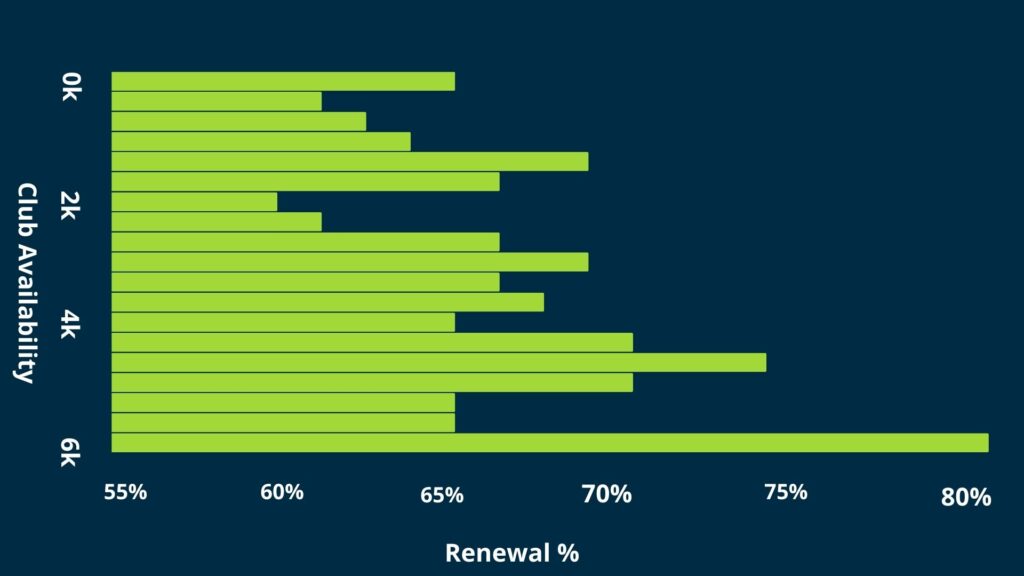


This white paper explores the importance of structuring a flexible membership model for golf clubs and its impact on renewal rates. It addresses key issues related to tee time availability within the tee sheet, exclusion of times, pricing strategies. Plus, we look at the use of technology to maximize renewal rates. By understanding these factors and making informed adjustments. Golf clubs can create a membership experience that not only attracts new members but also encourages existing members to renew their memberships.
Golf clubs face the challenge of retaining existing members and attracting new ones in a competitive market. One crucial aspect of achieving this is the development of a flexible membership structure that accommodates the diverse needs and preferences of golfers. This paper delves into the following areas:
The availability of tee times plays a pivotal role in member satisfaction and renewal rates. Excluding times and mismanaging availability can have adverse effects on a club’s ability to retain members.
The impact of pricing strategies, including marginal discounts and true price discounts, on renewal rates and member benefits.
How the use of technology, such as tee sheet management software and monitoring systems, can enhance renewal rates by ensuring advertised availability.
Tee time availability is a critical factor influencing member satisfaction and retention.
When members find it challenging to book tee times that align with their schedules, frustration sets in. This does lead to decreased renewal rates. Therefore, it is essential to manage tee time availability effectively.
Should You or Shouldn’t You Your Exclude Tee Times?
Excluding times from members’ access can be a double-edged sword. While it may be necessary to reserve certain tee times for events or maintenance, excessive exclusions can result in frustration and dissatisfaction among members.
Our data tracking members who don’t renew in their first-year highlights that those who book into the morning of weekends are least likely to renew their membership. This is a known area within the tee sheet that is either blocked entirely or requires manual intervention by clubs to enable bookings.
Where we experience increased customer service tickets and refunds are members who join via the advertised matrix. Upon booking, they discover no availability or worse availability either via GolfNow or the club’s website and cheaper. To address this issue:
Ensure that most tee times are available for Flexible members, even during peak hours. This communicates a sense of value to the membership. It is important to note that there is a limitation to how many rounds a member can play within their membership, along with being able to see an available slot only being achievable if full members have not utilised their privilege of a longer booking window.
Clearly communicate any exclusions well in advance and provide alternative options for members. On site amendments to tee sheets without consultation leads to high refund requests as the members expectation vs reality is not met.
Strike a balance between exclusions for Full members, tournaments, and unrestricted access for members. This can be achieved through careful scheduling and member input. Whilst morning weekend golf is prioritised to full members, it is often overlooked that the flexible member has a shorter booking window and will be required to expense higher points values for that round of golf. Offering these times to pay and play golfers who have not contractually engaged with the club in forward purchasing their golf for the season erodes the trade off the clubs seek to achieve in securing upfront membership revenue. Additionally, not enabling flexible members to play weekend mornings also deprives the club of valuable data regarding prospect full members.
The way golf clubs structure their pricing can significantly impact renewal rates. One common strategy is offering twilight golf at a marginal discount, but research suggests that this may not be the most effective approach.
Marginal discounts on twilight golf often attract occasional golfers who may not be interested in full memberships. While this can generate short-term revenue, it may not lead to higher renewal rates. Marginal discounts alone do not create a sense of membership value. Members may perceive the club as merely a transactional entity.
On the other hand, true price discounts provide members with genuine value and incentives to renew. These discounts can be combined with other member benefits such as pro shop discounts, dining privileges, and access to exclusive events. True price discounts build long-term loyalty and encourage members to renew year after year.
Ensuring the differential between available rates for pay and play golfers vs the points matrix is set at 20% has a pronounced impact on renewal rates upwards of 40% our data shows.
Whilst weekend morning golf has historically been the premium tee times within a club’s tee sheet. Growing evidence is showing post 6pm weekday golf is of equal importance to golfers during the summer. Given that this time is not always frequented by the full member, the feedback clubs receive typically from members around course capacity is sometimes overlooked.
This is where utilising course booking data is important as can be an underestimated source of yield enhancement to a club. Often this is where dynamic pricing may deliberately undervalue the true potential in value enhancement and is an area clubs should investigate further. Combined with member benefits and in club food and beverage discount, clubs can both command more revenue on and off the course in these valuable tee times.
Consideration should also be given to shorter form play. Formats such as three or six hole bookings, with combined meal or drink offers. All of which are achievable with variations to the points matrix and booking confirmations including discount codes.
Embracing technology can be a game-changer for golf clubs seeking to enhance renewal rates and member satisfaction.
Automated tee sheet systems often adjust tee times based on daylight saving time changes. However, it is important to understand the intricacies of such solutions. Whilst activating this module means a club does not have to worry about members booking 18 hole rounds that will finish in darkness. Unfortunately, it does remove the ability for 9 holes to be booked within the last 2 hours of daylight. This is because the configurations default to 18 hole availability. To maximise Flexible member utilisation, clubs should instead set their available booking times on a weekly or fortnightly basis ensuring 9 hole availability is displayed to a nine hole golfer.
This is a simple 2 minute task but in respect of payback, has a pronounced financial benefit in the form of renewal rate.
To maintain advertised availability, golf clubs should not just invest in tee sheet management software and monitoring systems but also invest time is understanding the functionality of their software. While these tools help ensure that tee times listed on the website, they do not always accurately reflect the actual availability. When members can trust the accuracy of tee time information, they are more likely to renew their memberships.
The graph below shows the correlation between clubs with high renewal rates and those that block out sections of the tee sheet. The price commanded for a weekend morning vs renewal rate does show a positive correlation with high renewal rates. Meaning flexible members are content to pay higher points for a weekend morning golf, but do not renew if the availability is removed or denied.

Structuring a flexible membership for golf clubs involves a strategic balance. The balance is between tee time availability, pricing strategies, and the use of technology. By prioritising member access, offering true price discounts, and embracing technology for course availability management, golf clubs can increase renewal rates and create a more attractive membership experience.
Ultimately, the goal is to create a sense of belonging and value for members, leading to higher satisfaction and loyalty. A well-structured flexible membership not only attracts new members but also encourages existing members to renew. This all helps towards ensuring the long-term success of the golf club.